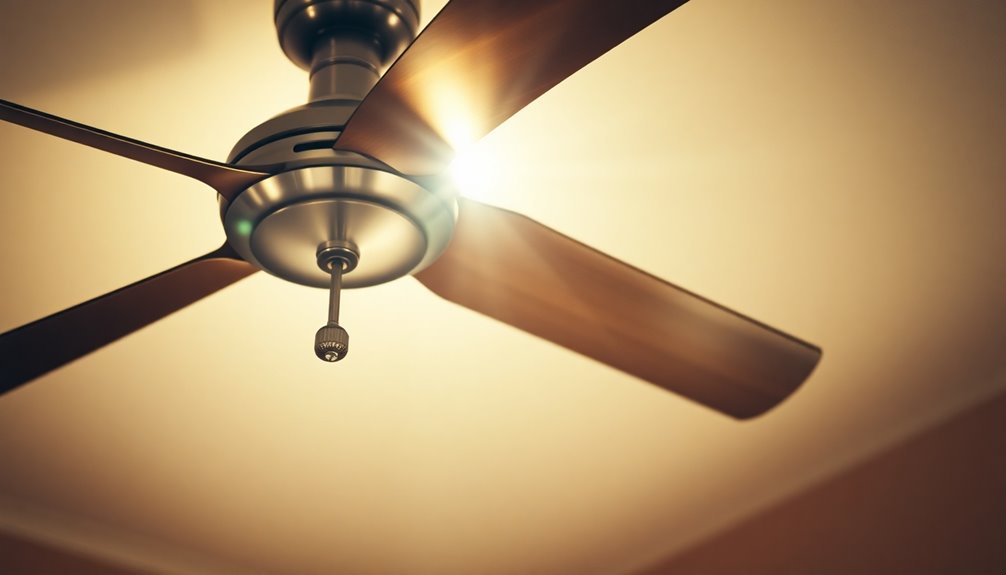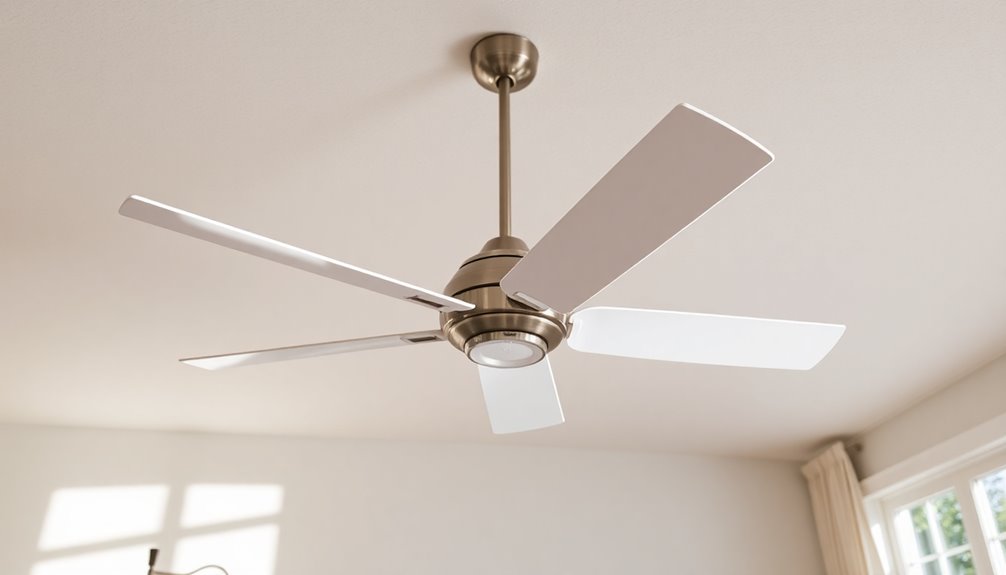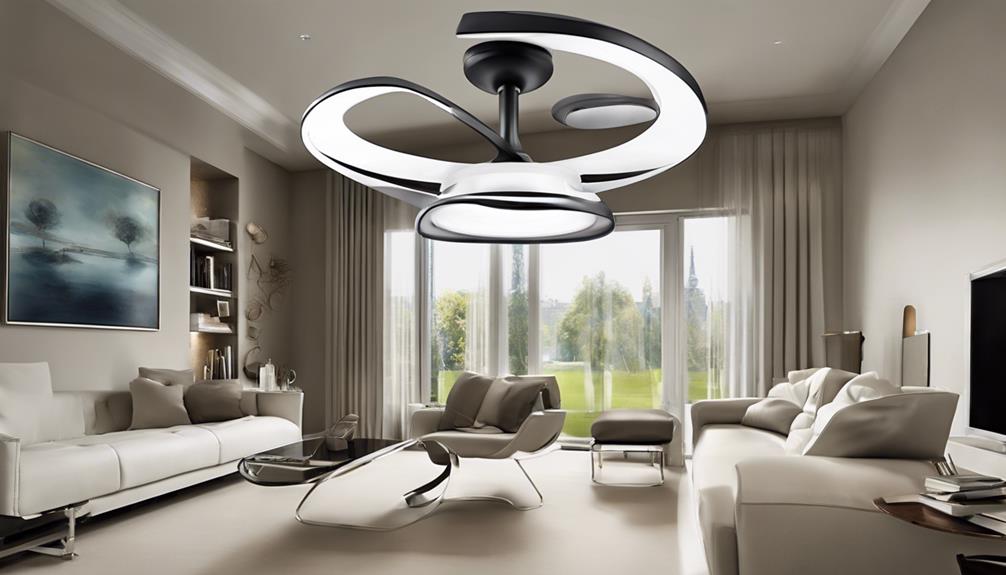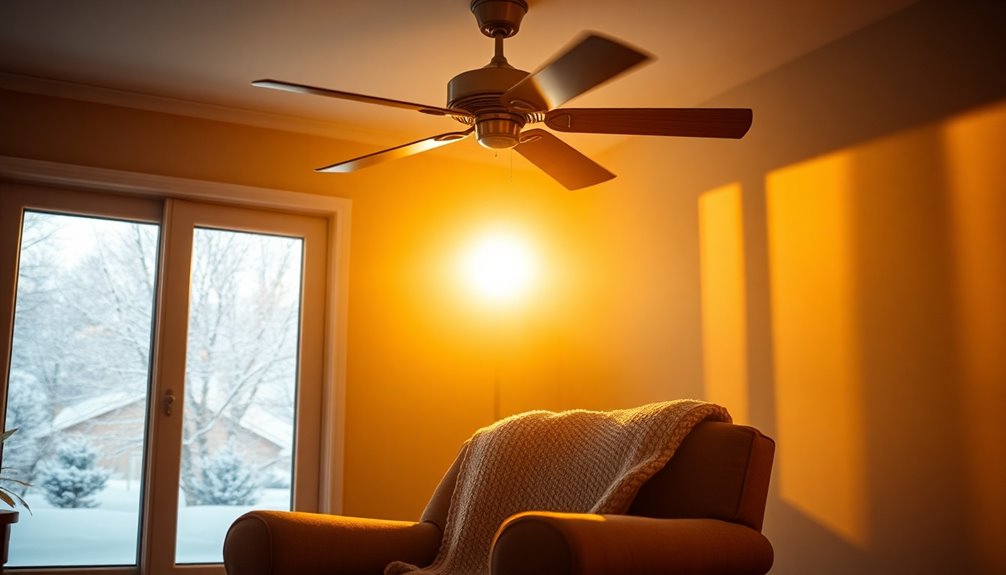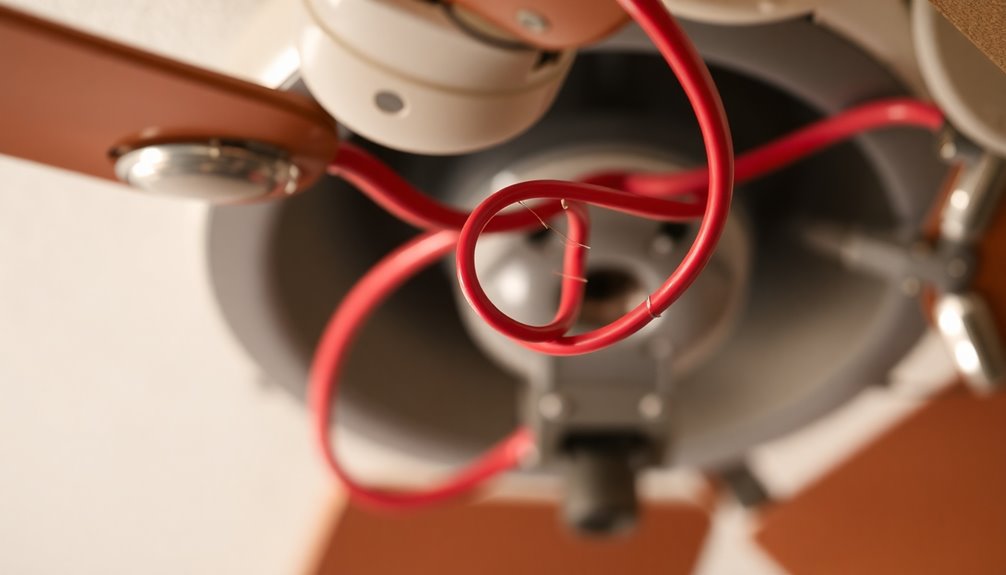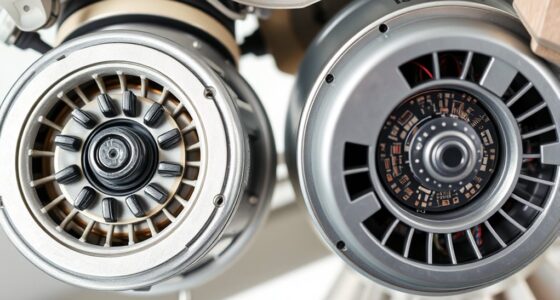If your ceiling fan won't turn on, several issues could be to blame. First, check the circuit breaker; a tripped breaker can cut power. Next, inspect the wiring for loose or damaged connections. A burnt capacitor might also prevent the fan from working. If you're using a remote, dead batteries or pairing issues could be the culprit. Additionally, consider whether the blades are damaged or imbalanced. Regular maintenance can help prevent these problems. For a more thorough understanding of what might be happening, look into additional troubleshooting options and solutions.
Key Takeaways
- Check the circuit breaker to ensure it hasn't tripped, cutting off power to the fan.
- Inspect wiring connections for any loose or damaged parts that may disrupt power flow.
- Test the remote control batteries; dead batteries can prevent fan operation.
- Look for a burnt capacitor, which can cause the motor to fail or respond improperly.
- Ensure the fan blades are balanced and undamaged, as imbalances can hinder motor startup.
Common Causes of Malfunction

When your ceiling fan suddenly stops working, it can be frustrating and leave you wondering what went wrong. One of the common causes might be loose wiring. If the connections aren't secure, power flow to the fan is disrupted, preventing it from turning on.
Another culprit could be a burnt capacitor, which interrupts the motor's functionality and results in complete fan failure. You might also encounter insufficient power supply due to voltage fluctuations or issues within the electrical circuit. These fluctuations can prevent your fan from operating as intended.
Additionally, a tripped circuit breaker may cut off power to your fan, so check your breaker panel and reset it if necessary.
Lastly, while imbalanced or damaged fan blades typically affect performance rather than activation, they can still hinder the motor's ability to start. If the blades are stuck or improperly aligned, it might also prevent the fan from turning on.
Troubleshooting Power Issues

When your ceiling fan isn't working, the first step is to check the circuit breaker status to see if any switches have tripped.
Next, inspect the wiring connections for any loose or damaged parts that could be disrupting power flow. Regular maintenance, similar to how you would replace air purifier filters, can help prevent these issues from arising in the future.
Addressing these issues can often restore functionality to your fan. Additionally, ensure that the fan's motor is not experiencing any mechanical failures that could prevent it from operating properly.
Check Circuit Breaker Status
Checking the circuit breaker status is an essential step in troubleshooting power issues with your ceiling fan. Start by locating your home's circuit breaker panel and checking for any tripped breakers that may affect the fan's power supply. If you find a tripped circuit breaker, flip it back to the ON position and test the fan. It might just start working again!
However, if the breaker keeps tripping after you reset it, you could be facing a more serious electrical issue that requires professional evaluation. It's important to verify that the circuit breaker is correctly rated for the ceiling fan to prevent overloads. Typically, a 15-amp breaker is standard for lighting circuits.
If your fan is on a dedicated circuit, be sure to check for other devices sharing the same circuit that may be drawing too much power. Excessive load can easily cause the circuit breaker to trip.
Inspect Wiring Connections
Your ceiling fan's wiring connections play an essential role in its operation, and loose or damaged connections can prevent it from turning on. To guarantee power to your fan, start by inspecting wiring connections carefully.
Follow these steps to troubleshoot:
- Check for loose screws: Look at all the connections, both at the ceiling fan motor and in the switch housing. Tighten any screws that may have come loose over time.
- Inspect for damaged wiring: Examine the wires for any signs of wear or corrosion. Damaged wiring can disrupt the electrical flow, causing your fan to malfunction.
- Use a circuit tester: To check for voltage, use a circuit tester at the fan's connection point. This will confirm if power is reaching the unit.
- Reset the breaker: If you suspect a tripped circuit breaker, resetting the breaker can restore power to your fan.
Don't forget to confirm that the pull chain or wall switch is in the "on" position, as this can sometimes be easily overlooked during troubleshooting.
Motor and Speed Control Problems

When your ceiling fan isn't responding to speed changes, it might be due to a faulty capacitor or wiring connection issues.
These problems can prevent the motor from functioning properly, leading to frustration when you just want some airflow.
Let's explore how to identify and fix these motor and speed control problems.
Capacitor Malfunction Issues
Sometimes, a ceiling fan just won't cooperate, and a malfunctioning capacitor might be the culprit. The capacitor is essential for regulating the ceiling fan motor's power and speed. If it's faulty, your fan may not turn on at all or may only operate at one speed.
You might notice some signs indicating a bad capacitor, like a humming sound from the motor without any blade movement or erratic fan speed changes when you adjust the settings.
To troubleshoot capacitor issues, consider these steps:
- Listen for Humming: If you hear a humming sound but the blades aren't moving, it could indicate a capacitor problem.
- Check for Continuity: Use a multimeter to test the capacitor for continuity; a lack of it means you'll need to replace it.
- Inspect for Burnt Components: Look for visible damage or burnt marks on the capacitor.
- Replace if Necessary: If the capacitor is indeed faulty, replacing it's often a cost-effective solution to restore your fan's functionality.
With these steps, you can tackle common fan issues related to the capacitor effectively!
Wiring Connection Problems
One major issue that can prevent a ceiling fan from working properly is wiring connection problems. Loose or damaged wiring connections can stop power from reaching the fan motor, leaving it non-operational. When you're troubleshooting, start by inspecting all wiring connections for wear, fraying, or disconnections. These are common culprits in ceiling fan failures.
Additionally, a faulty capacitor within the fan motor can hinder power transmission, affecting the fan's ability to operate at any speed. If the wiring harnesses are worn or damaged, they disrupt the necessary signal transmission for speed control and overall functionality.
Make sure all wiring connections are secure and properly insulated to reduce the risk of electrical shorts, which can also prevent the fan from turning on. If you find any loose connections, tighten them up. If the wiring looks damaged, it may need replacing.
Lighting Issues and Solutions

Troubleshooting lighting issues with your ceiling fan can often resolve the problem quickly and easily.
Start by checking the basics to identify what might be causing the lights to fail. Here are four steps to guide you:
- Inspect the Bulbs: Check if any bulbs are burnt out or improperly installed. A single dead bulb can prevent the whole light fixture from working.
- Examine the Bulb Socket: Look for burn marks in the bulb socket, which may indicate wiring issues. If you see any, it's best to consult a professional.
- Check the Power Supply: Verify that the power supply to the light fixture is active. Confirm that the switch controlling the light is functioning properly.
- Refer to the Manufacturer's Manual: Different ceiling fan models may have unique troubleshooting steps. Always consult the manufacturer's manual for guidance on specific issues.
Noise and Remote Control Fixes

While enjoying the comfort of your ceiling fan, you might notice some unexpected noises or issues with the remote control. If your fan isn't responding, start by checking the batteries in the remote. Make sure they're functional and installed correctly.
If the batteries are fine, it's time to inspect the remote and verify it's paired with the fan's receiver. Sometimes, re-pairing is necessary if the fan isn't responding to commands.
Next, power off the fan at the circuit breaker before diving deeper into ceiling fan troubleshooting. This step guarantees your safety while you inspect the receiver connections. Look for any loose wires or damage in the mounting bracket that could affect the remote's functionality.
If you've checked the batteries and receiver connections but the remote still isn't working, consider replacing the remote or the receiver. One of them might be faulty, causing the issues you're experiencing.
Maintenance and Care Tips

To keep your ceiling fan running efficiently, regular maintenance is crucial. Neglecting care can lead to reduced performance, noise issues, or even safety hazards.
Follow these maintenance and care tips to guarantee your ceiling fan operates smoothly:
- Clean ceiling fan blades: Dust buildup can hinder airflow efficiency. Wipe the blades regularly to maintain performance.
- Inspect and tighten screws: Periodically check the screws on the fan blades and light kits. Tightening any loose screws can minimize noise and guarantee secure connections.
- Lubricate the motor: Annually, lubricate the motor's ball bearings to keep it operating smoothly and prevent overheating.
- Check electrical components: Look for any signs of wear or damage in the wiring. If you notice any issues, replace any damaged wiring immediately to enhance safety and functionality.
Additionally, consider scheduling professional maintenance every few years. This can help identify potential issues early and keep your fan in prime working condition.
Replacement Considerations

Considering a replacement for your ceiling fan can be a challenging task, especially if you're unsure what to look for. Start by identifying operational issues with your current fan, such as visible damage or outdated design. Here are some replacement considerations to keep in mind:
| Aspect | Importance | Tips |
|---|---|---|
| Energy Efficiency Ratings | Reduces electricity consumption and costs | Look for fans with high ratings |
| Ceiling Fan Types | Different styles and sizes fit various rooms | Research options that meet your needs |
| Compatibility with Light Kits | Guarantees seamless integration with lighting | Check specifications before buying |
| Warranty and Return Policies | Protects against defects or dissatisfaction | Always read the fine print |
When selecting a replacement ceiling fan, consider your air circulation requirements to guarantee peak performance. You want a fan that not only suits your space but also aligns with your aesthetic preferences. Additionally, focusing on energy-efficient models can significantly reduce electricity costs. Modern fans often come with advanced technology integration that can enhance functionality and user experience. Regular maintenance and cleaning of your ceiling fan can also prolong its lifespan and efficiency. Don't hesitate to consult store experts or online resources, like The Home Depot Mobile App, to guide you toward the right choice. Taking these factors into account will help you find a fan that enhances your home environment effectively.
When to Seek Professional Help

Even with the best replacement options, there are times when a ceiling fan still encounters issues that you can't fix on your own.
If your ceiling fan stops working despite your efforts, it might be time to seek professional help. Here are four situations where calling a licensed electrician is vital:
- Electrical Issues: If the fan remains unresponsive after checking the electrical panel and connections, you may be facing deeper wiring problems that require a professional assessment.
- Frequent Breaker Trips: If you notice frequent tripping of circuit breakers tied to the fan, it's a sign of potential wiring problems that need expert attention.
- Loose Wiring: If you suspect loose wiring but can't safely access it, it's best to let a professional handle it to avoid electric shock.
- Motor Failure Signs: If your fan hums without blade movement, that could indicate motor failure, warranting a professional evaluation for replacement options.
In complex electrical systems, an electrician can help guarantee everything functions properly while preventing misdiagnosis.
Don't hesitate to reach out for help when necessary!
Frequently Asked Questions
How Do You Fix a Ceiling Fan That Won't Turn On?
To fix a ceiling fan that won't turn on, start by checking the power supply.
Make sure the light switch is on and the circuit breaker hasn't tripped.
Inspect the wiring inside the fan for loose connections.
Use a multimeter to test the fan switch.
Confirm the pull chain or remote is engaged.
If it's still not working, you might need to replace the capacitor, as a faulty one can prevent the motor from operating.
Why Would a Ceiling Fan Suddenly Stop Working?
A ceiling fan might suddenly stop working for several reasons. You could have loose wiring connections disrupting the power flow.
Burnt capacitors might be preventing the motor from functioning. Check for voltage fluctuations or tripped circuit breakers that could interrupt the power supply.
Imbalanced or damaged blades might cause excessive wobbling, triggering safety features.
Finally, a malfunctioning switch or remote could fail to send the signal needed for operation.
How to Reset a Ceiling Fan?
To reset your ceiling fan, start by turning off the power at the circuit breaker for safety.
Wait about five minutes before switching the power back on. This allows the fan's internal controls to reset.
If your fan has a reset button on the motor housing, press it.
For fans with remote controls, take out the batteries for a few minutes.
Finally, check any smart app settings if your fan has smart technology.
How Do You Fix a Fan That Won't Turn?
When your fan feels like a dormant butterfly, it's time to wake it up.
Start by checking the power supply; verify the circuit breaker's not tripped, and the light switch is on.
Next, inspect the wiring for loose connections.
Use a multimeter to test the switch, and look for any obstructions in the blades.
If it still won't budge, consider replacing the capacitor or motor to bring it back to life!
Conclusion
In summary, if your ceiling fan won't turn on, don't panic; you're not alone. About 15% of homeowners experience similar issues at some point. By troubleshooting common problems, from power supply to motor issues, you can often resolve the situation yourself. Regular maintenance can also prevent future hiccups. If all else fails, don't hesitate to call in a pro to guarantee your fan's back up and running, bringing comfort to your space once again!
